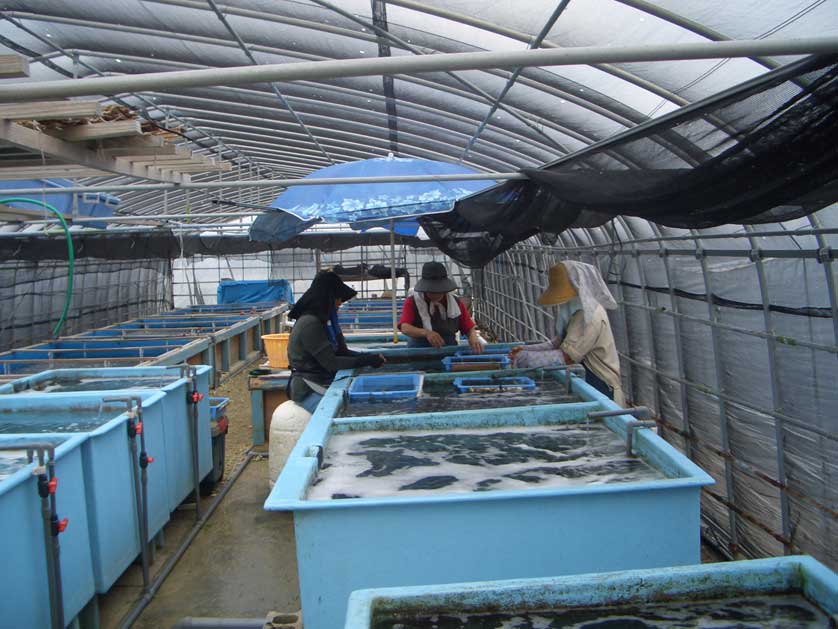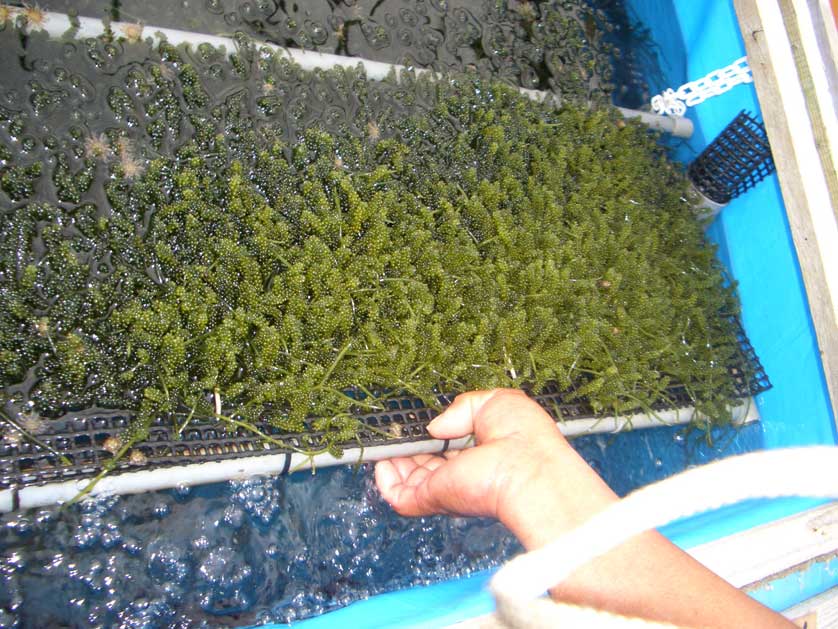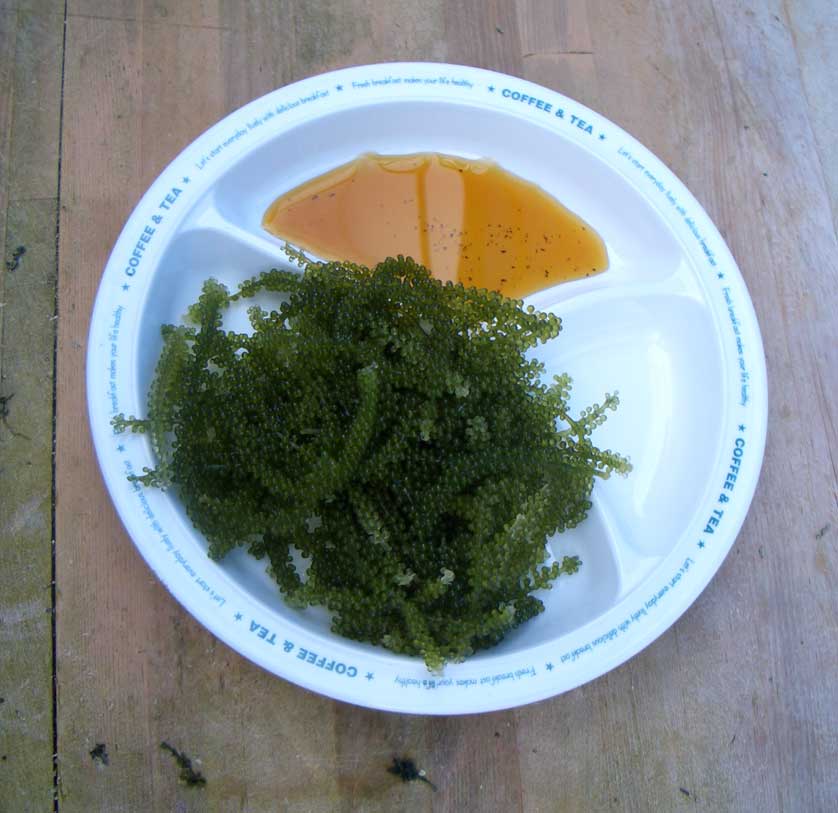Umibudo Sea Grapes: A Delicate Japanese Delicacy
- Published on : 25/06/2024
- by : Japan Experience
- Youtube
Umibudo, also known as sea grapes or green caviar, is a unique seaweed delicacy that has captured the hearts and palates of food enthusiasts around the world. Originating from the warm waters of Okinawa, these tiny, grape-like clusters offer a burst of oceanic flavor and a delightful texture. In this article, we'll explore the fascinating world of umibudo, from its origins and cultivation to its nutritional benefits and culinary applications.
What are umibudo sea grapes?
Umibudo, scientifically known as Caulerpa lentillifera, is a species of edible green algae found in the shallow coastal waters of the Indo-Pacific region. The name "umibudo" literally translates to "sea grapes" in Japanese, aptly describing its appearance of small, green, grape-like bubbles clustered along slender stems. These delicate seaweed strands resemble miniature bunches of grapes, with each bubble measuring about 1-2 mm in diameter.
Unlike true grapes, umibudo is a type of seaweed that grows underwater, typically at depths of 2-3 meters. The plant consists of a creeping stolon that anchors itself to the ocean floor, from which upright branches grow, bearing the characteristic grape-like vesicles. These vesicles are what give umibudo its unique texture and flavor, bursting with a slight pop when eaten, releasing a salty, briny taste of the sea.

Origin and cultivation of umibudo
While umibudo grows naturally in various parts of the Indo-Pacific, it has become particularly associated with Okinawa, Japan, where it has been cultivated and popularized as a local specialty. The cultivation of umibudo in Okinawa dates back to the late 1980s when local fishermen and researchers began exploring ways to farm this unique seaweed.
Initially, umibudo was harvested from the wild, primarily around Miyako Island. However, as demand grew, sustainable farming methods were developed. Today, umibudo is primarily cultivated in controlled environments, such as land-based aquaculture systems or protected coastal areas. The main production centers in Okinawa include Onna Village, Miyako Island, and parts of the Yaeyama archipelago.
Cultivation typically involves growing umibudo in large tanks filled with clean seawater. The seaweed is attached to nets or ropes and carefully monitored for optimal growth conditions, including water temperature, salinity, and nutrient levels. It takes about 30-60 days for umibudo to reach harvestable size, depending on the season and growing conditions.


Taste and texture: The ocean's caviar
Umibudo is often referred to as "green caviar" due to its appearance and texture, but its taste is uniquely its own. When eaten, the small vesicles burst in the mouth with a satisfying "puchi-puchi" sensation, releasing a burst of flavor that is both refreshing and distinctly oceanic.
The taste of umibudo is primarily salty with a subtle sweetness. It has a clean, crisp flavor that evokes the freshness of the sea without being overly fishy. The texture is what truly sets umibudo apart - each little sphere pops gently between the teeth, creating a playful eating experience that is both fun and flavorful.
Many describe the flavor as a perfect balance of brininess and umami, with a slight mineral quality that lingers on the palate. This unique combination of taste and texture makes umibudo a versatile ingredient in various dishes, from simple appetizers to more complex culinary creations.
Nutritional benefits of umibudo
Beyond its unique taste and texture, umibudo is prized for its nutritional content. Like many seaweeds, it is low in calories but rich in essential minerals and vitamins. Some of the key nutritional benefits of umibudo include:
- High in minerals: Umibudo is an excellent source of calcium, iron, magnesium, and iodine.
- Rich in vitamins: It contains significant amounts of vitamins A, C, and K.
- Good source of dietary fiber: Helps promote digestive health and feelings of fullness.
- Low in calories: With only about 4 calories per 100 grams, it's an ideal food for weight management.
- Contains antioxidants: May help protect against cellular damage and support overall health.
In Okinawa, where umibudo is a staple food, it is often cited as one of the factors contributing to the region's legendary longevity. While more research is needed to confirm its specific health benefits, umibudo is generally considered a nutritious addition to a balanced diet.
How to eat and serve umibudo sea grapes
Umibudo is incredibly versatile and can be enjoyed in various ways. Here are some popular serving suggestions:
- Raw as a snack: Simply rinse the umibudo in fresh water and enjoy it as is, savoring the natural flavor and texture.
- As a topping: Sprinkle umibudo over rice bowls, salads, or sashimi for added texture and flavor.
- In sushi: Use umibudo as a topping for nigiri or incorporate it into Izakaya - the Japanese pub style sushi rolls.
- With dipping sauces: Serve umibudo with light dipping sauces like ponzu or a mixture of rice vinegar and soy sauce.
- In salads: Mix umibudo with other seaweeds or vegetables for a refreshing seafood salad.
- As a garnish: Use it to add a pop of color and texture to various dishes, from soups to grilled seafood.
When preparing umibudo, it's important to handle it gently to preserve its delicate texture. Avoid cooking umibudo, as heat can cause the vesicles to burst and lose their characteristic pop. Instead, focus on serving it fresh or lightly chilled to maintain its crisp texture and flavor.

Purchasing and storing umibudo
While umibudo is readily available in Okinawa and other parts of Japan, it can be more challenging to find in other countries. However, as its popularity grows, it's becoming increasingly available in specialty Asian markets and through online retailers.
When purchasing umibudo, look for bright green clusters with firm, intact vesicles. Avoid any that appear slimy, discolored, or have an off-odor. Fresh umibudo is often sold packed in saltwater to maintain its freshness.
To store umibudo:
- Keep it in its original packaging or transfer it to an airtight container.
- Store at room temperature, not in the refrigerator, as cold temperatures can damage the delicate seaweed.
- Use within 3-4 days of purchase for the best flavor and texture.
- Before serving, rinse gently in fresh water to remove excess salt.
Some suppliers also offer dried umibudo, which can be rehydrated before use. While convenient for long-term storage, the texture of rehydrated umibudo may not be as crisp as fresh varieties.

Umibudo in Japanese cuisine and culture
In Okinawa, umibudo has become more than just a food - it's a cultural icon and a symbol of the region's rich culinary heritage. Often served in local Drinking in Japan establishments alongside Okinawan specialties like goya champuru (bitter melon stir-fry) and rafute (braised pork belly), umibudo adds a touch of elegance and freshness to the meal.
The popularity of umibudo has spread beyond Okinawa to mainland Japan and internationally. It's now featured in high-end Japanese restaurants worldwide, often as a garnish for sashimi or a topping for creative fusion dishes. Its unique texture and visual appeal make it a favorite among chefs looking to add an element of surprise and delight to their creations.
Beyond its culinary uses, umibudo has also found its way into the wellness and beauty industries. Some cosmetic companies in Japan have begun incorporating umibudo extract into skincare products, touting its mineral-rich composition and potential anti-aging properties.
As interest in Japanese cuisine and culture continues to grow globally, umibudo stands out as a fascinating example of how traditional foods can find new appreciation in modern contexts. Whether enjoyed as a simple snack with a cold Kirin Beer or as part of an elaborate omakase experience, umibudo offers a unique taste of the sea that continues to captivate food lovers around the world.
For those interested in exploring more about Japanese cuisine, including the role of unique ingredients like umibudo, there are many excellent Books on Japan & Japanese Cuisine available that delve deeper into this fascinating culinary world.









